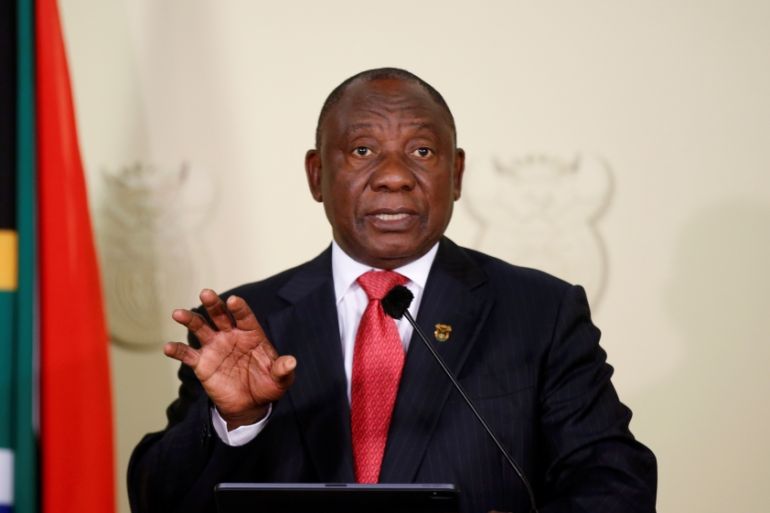South Africa announces $26bn COVID-19 rescue package
The package, equivalent to 10 percent of the country’s GDP, will cushion the economic blow of the coronavirus pandemic.

South African President Cyril Ramaphosa has announced a 500 billion rands ($26.3bn) rescue package, equivalent to 10 percent of the gross domestic product (GDP) of his country, to try to cushion the economic blow of the coronavirus pandemic.
“The pandemic requires an economic response that is equal to the scale of the disruption it is causing,” he said in an address on national television on Tuesday, pledging to “address the extreme decline in supply and demand and to protect jobs”.
Keep reading
list of 3 itemsAfrica coronavirus cases could hit 10 million in six months: WHO
Africa does not need saving during this pandemic
Ramaphosa said South Africa had approached global financial institutions like the World Bank, International Monetary Fund, the BRICS New Development Bank and the African Development Bank, primarily to fund healthcare interventions.
The rest of the package would be financed by a mix of 130 billion rands ($6.9 bn) of reprioritised spending and other local sources.
Among the measures were 200 billion rands ($10.6bn) in loan guarantees in partnership with the central bank, finance ministry and commercial banks, and tax deferral for firms with more than 100 million rands ($5.3m) turnover.
Early on in South Africa’s coronavirus crisis, Ramaphosa took drastic measures to try to prevent the kind of runaway epidemic that has devastated the United States and much of Europe.
At the end of March, he announced one of the toughest lockdowns anywhere in the world, banning anyone but essential workers from leaving home except to buy food or medicine, and prohibiting alcohol sales, when South Africa had just 400 cases.
He also deployed the army on the streets to enforce it and rolled out mass testing that has so far seen 127,000 people tested, of whom 3,465 are positive, according to the latest ministry of health figures. Fifty-eight people have died, according to data from Johns Hopkins University.
While the measures appear to have halted a steep rise in new cases, the economic impact of the lockdown is wreaking havoc on an economy that was already in recession, and with a third of the country out of work.
It also threatens to push South Africa’s poor, who on one measure make up half of the country, deeper into poverty.
A large part of the workforce is in the low-income informal sector. Ramaphosa announced special increases to the monthly social grants upon which about 16 million of South Africa’s 57 million people rely for survival.
The virus and measures to contain it will continue to take a severe toll “in the weeks and months to come”, with many people losing their jobs, the president said. Unemployment already had been 29 percent. The central bank now projects that the GDP will fall by up to 6.1 percent this year.
South Africa’s lockdown is set to continue until May 1. While painful, it has been “absolutely necessary” to save tens of thousands of lives, Ramaphosa said. The loosening of the lockdown will take a “risk-adjusted approach”, he added.
Ramaphosa will address the nation on Thursday with details on a “phased approach, guided by the best available scientific evidence, to gradually lift the restrictions on economic activity”.
Other African countries are implementing relief and social welfare programmes for their citizens, although none on the scale of South Africa.